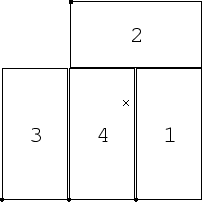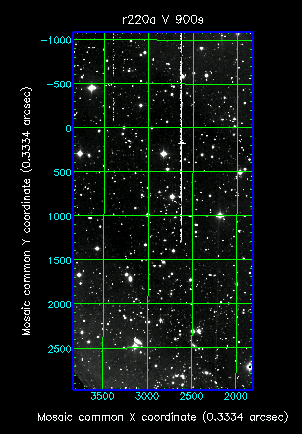
The Wide Field Camera instrument on the Isaac Newton Telescope contains four CCD chips of 2048 x 4096 pixels positioned roughly, but not exactly, as follows:
In order to do accurate astrometry with data obtained from this instrument, it is necessary to correct for the exact orientation and position of each CCD in relation to the others, as well as for nonlinear distortions away from the optical axis of the focal plane introduced by the optics of the telescope. The nonlinear distortion is very well modelled by a radial ``pincushion'' transformation, which has the form
The following transformations take account of both these effects to map the pixel coordinates (xi, yi) of CCD#i into a new pixel-like coordinate system (x', y') of uniform scale, which is the same for all four CCDs. The origin of this coordinate system is at pixel coordinates (1778, 3029) of CCD#4, which is taken to be on the optical axis. At this point, one unit of the new coordinate system is equivalent to one pixel of the CCD#4 system, so that the new coordinates are almost equivalent to CCD#4 coordinates, although they diverge away from the origin thanks to the nonlinear distortion. Each unit of the new coordinates has the same size, which is approximately 0.333 arcsec.
The corrected coordinates (x', y') are obtained from
each set of pixel coordinates (xi, yi)
by first translating so that the origin is on the optical
axis, then rotating to the correct angle,
then correcting for the radial distortion effect:
![\begin{eqnarray*}
x_i^{\rm shift} & = & x_i - X_i \\
y_i^{\rm shift} & = & y_...
...ot} \right.^2
+ \left. y_i^{\rm rot} \right.^2
\right] \right)
\end{eqnarray*}](img1.gif)
Values for these coefficients have been obtained by registering
two exposures of the same region of sky, in which the instrument
had been rotated by 180![]() between exposures.
The value of (X4, Y4) was taken from the value used
for the
Wide Field Survey
data, and
between exposures.
The value of (X4, Y4) was taken from the value used
for the
Wide Field Survey
data, and ![]() was chosen to be zero.
The values of the coefficients in these equations are approximately:
was chosen to be zero.
The values of the coefficients in these equations are approximately:

These values of the coefficients are thought to be correct to an accuracy of 1 or 2 pixels, which is around half an arcsecond.
The following image gives an exaggerated representation of the shapes and positions of the CCDs as mapped on to the new coordinate system. The dots in the corners of the CCDs mark the pixel origin for each CCD and the `` x '' marks the origin of the unified coordinate system.
For users of Starlink software, the calibrated coordinate information can be attached automatically to image files using the ASTIMP command, and the file INT-WFC.ast
There are a couple of provisos for using this facility: first, it is best if the files are converted to Starlink NDF format using the CONVERT package as follows:
% convert CONVERT commands are now available -- (Version 1.2-4, 2000 January) Defaults for automatic NDF conversion are set. Type conhelp for help on CONVERT commands. Type "showme sun55" to browse the hypertext documentation. % fits2ndf in='r10628?.fits' out='*'which will convert the FITS file r106280.fits into the NDF r106280.sdf and so on. The Starlink software will in fact work with FITS files, but because it converts them on the fly between FITS and NDF formats before and after each command, this can be rather slow with files the size of WFC frames.
Secondly, you must have CCDPACK version 3. This will be in the Starlink Spring 2000 release, which at the time of writing this document has not been distributed. However, copies can be obtained on request from Mark Taylor at m.b.taylor@bris.ac.uk.
Once the file is in Starlink NDF format, then obtain the file INT-WFC.ast and from the Unix C shell do the following:
% ccdpack
CCDPACK commands are now available -- (Version 3.0-1)
For help use the commands ccdhelp or ccdwww
% astimp in='r10628?' astfile=INT-WFC.ast reset accept
ASTIMP
======
Framesets read from file INT-WFC.ast:
FITS header "ROTSKYPA" used for rotation
N Base domain Current domain Frameset ID
-- ----------- -------------- -----------
1 PIXEL INT-WFC FITSID CHIPNAME 'A5506-4'
2 PIXEL INT-WFC FITSID CHIPNAME 'A5383-17-7'
3 PIXEL INT-WFC FITSID CHIPNAME 'A5530-3'
4 PIXEL INT-WFC FITSID CHIPNAME 'A5382-1-7'
4 NDFs accessed using parameter IN
Processing NDF /data/cass58a/mbt/data/int4/r106280
Matched with frameset ID "FITSID CHIPNAME 'A5506-4'"
Rotating additional 180 degrees
New frame in domain "INT-WFC" added
Processing NDF /data/cass58a/mbt/data/int4/r106281
Matched with frameset ID "FITSID CHIPNAME 'A5383-17-7'"
Rotating additional 180 degrees
New frame in domain "INT-WFC" added
Processing NDF /data/cass58a/mbt/data/int4/r106282
Matched with frameset ID "FITSID CHIPNAME 'A5530-3'"
Rotating additional 180 degrees
New frame in domain "INT-WFC" added
Processing NDF /data/cass58a/mbt/data/int4/r106283
Matched with frameset ID "FITSID CHIPNAME 'A5382-1-7'"
Rotating additional 180 degrees
New frame in domain "INT-WFC" added
This command sets the Current coordinate frame of the specified
NDF files to the new coordinate system (x',y') described above.
As well as applying the linear and nonlinear geometry terms whose
coefficients were given,
it also rotates the coordinates according to the value of the
ROTSKYPA FITS header card, which records the orientation of the
turntable when the observation was made;
in this case it was oriented at 180Once the new coordinate system has been attached to the images, then most Starlink applications will make use of this as appropriate. If you display any of the images using KAPPA's DISPLAY application, the axes will show the coordinates in the new frame:
% kappa KAPPA commands are now available -- (Version 0.13-7) Type kaphelp for help on KAPPA commands Type "showme sun95" to browse the hypertext documentation % display r106282 style='"grid=1,gap=500"'will give the following display:
Close inspection will show that the grid is not quite parallel to the sides of the image, or straight, because of the slight rotation from the vertical and nonlinear distortion.
If some of the frames overlap, the corresponding X and Y offsets can then easily be determined using CCDPACK's object matching registration facilities.
This calibration was done on Starlink time with assistance from Peter Draper and David Gilbank in Durham.